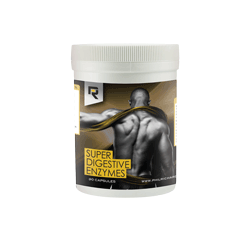With all our programmes including personal training, group training and semi private personal training here at our facility in Maynooth we always encounter issues with digestion. It has led me over the years to ensure that we have this covered so that you can improve your digestion.
You are not what you eat – but what you absorb
Our way of coaching is when presented with questions we know or find the answers. Over the years here are the most common questions we have faced with answers that will shock you.
What Happens to My Food?
The digestive tract is a tube from the opening and functions of the mouth and the salivary glands to the excretion through the anus and it is this journey that brings your food from processing to elimination.
A simplistic approach also takes into account the diverted roles from the ‘tube’ of the gallbladder, liver and pancreas and their enzyme roles they play.

How to improve your digestion
Take for example a jam sandwich. From the moment the food hits the mouth pytalin is released to breakdown the starch within the food. That is why bread will begin to taste sweet once left in the oral cavity. Starches are already being broken down releasing the starch within the foods (Plummer, 2010). Fat digestion also occurs with lingual lipase which works over a broad pH range enabling it to start lipid digestion immediately. Because it works over such a broad pH range it can continue to work after the chyme has left the stomach (Martini et al 2008).
Chewing is a crucial part of the process. After all your stomach doesn’t have teeth!
The food bolus once swallowed takes around 9 seconds to reach the stomach with the food residing in the gut for around 2 hours. Food remains in the small and large intestine for around 18 hours. Constipation can be classified as anything over 90 hours. Overall the size of the GI tract is around 4.6 metres long and the area of the small intestine if spread out would cover a tennis court! (Plummer, 2010). Its structure dictates its function as a primary absorber of nutrients.
Once in side the stomach (aka the collection) digestion will continue until the mashed food item has been mixed with the gastric juices that are being released by the gastric glands. This combination of water, enzymes and hydrochloric acid begins to break down proteins with the combination HCL and protease enzymes.
To protect themselves from the acidity of the HCL the stomach walls secrete mucus (Rolfes at al 2006). The gastric juices are produced to also kill off bacteria (Holford, 2007) – one of first lines of defence against the any unwanted bacteria and pathogens.
By the time the food has left the stomach digestion of carbohydrates, proteins and fats will be in full swing as they reach the small intestine. Pancreatic juices and liver juices mix with the food which can now be called ‘chyme’ to then allow exposure to the intestinal wall across which absorption can occur. Pancreatic juices secrete sodium bicarbonate which neutralises the gastric juices.
The pancreatic enzymes inclucding pancreatic alpha-amylase, lipase, nucleases, proteolytic enzymes (which include proteases and peptidases). Proteolytic enzymes are inactive at first. Amongst the proenzymes include trypsinogen, chymotrypsinogen, procarboxypeptidase and proelastase. Once inside the duodenum enterokinase triggers the conversion of trypsinogen into trypsin. Trypsin then activates chymotrypsin (Martini et al 2008).
The liver is a bile storage site with the gallbladder pouring its contents of bile over the food so that fat can be emulsified.
If you have had your gall bladder removed you will still manufacture bile but it will not be as concentrated. That is why it is a good idea to supplement your meals with lecithin granules as this is a key emusifier of fat.
Once this has occurred absorption must occur and your food has to find a way of becoming some use! To that extent most absorption takes place in the small intestine (Rolfes et al). Simple diffusion of simple nutrients like water and small lipids cross the intestinal walls freely.
Other nutrients such as water soluble vitamins are absorbed by facilitated diffusion which means they need a specific carrier to transport them from one side of the cell to the other.
Some nutrients must be absorbed actively such as glucose and amino acids which means these nutrients move across a concentration gradient which requires energy.
The large intestine prepares the waste for removal. The ileo-caecal valve prevents food from moving back to what Holford calls ‘the kitchen area’. In the ‘waste area’ food is prepared for removal largely undigested food, bacteria, fibre and dead cells. Once this area is full defecation is triggered and the removal of the waste is begun.
Take Home – Your digestive tract is one long tube and lots can happen on the way. Knowing this will lead you to know where to look.
What can go wrong along the way?
Here are a list of common problems associated with the gut
Dysbiois – a term coined in 1900 by Dr. Eli Metchinikoff. It points to an imbalance in the gut of bad to good bacteria. According to Elizabeth Lipski there are four kinds
Putrefecation Dysbiosis – when the food is not broken down effectively leading to a build up of Bacteroides and too few of the good bacteria (Bifidobacteria). Bacteroides breakdown Vitamin B12 leading to lethargy, fatigue and depression. This will show up with a stool test in the form of undigested carbs, fats and proteins and a high level of beta-glucoronidase. If you wish to order a Comprehensive Digestive Stool Analysis then please call us on 01 5052131.
Fermentation Dysbiosis – when the imbalance favours those that ferment carbohydrate. Some people feel worse after eating sugars. This will show up in a stool test in the form of the presence of Candida Albicans.
Deficiency Dysbiosis – this could be the result of a antiobiotics and infection leading to a deficiency of good bacteria. Until levels are restored there will issues. A stool test will show this up as lacking in good bacteria.
Sensitisation Dysbiosis – this occurs when the gut immune response becomes highly sensitised to food particles and substances produced by microbes. The person will be multi-allergenic and suffer from various auto-immune conditions. Abnormal levels of immunoglobulin A will show up here in tests.
Candida Albicans is another common digestive issue. According to Richards and Young, changing the environment is the common method of resoving this issue. From personal experience, 7 days is a common period for improvement in symptoms. But don’t expect this to be pleasant. Sugar cravings, migraines, fatique, lethargy and poor sleep are all common side-effects.
This is resolved by following a strictly 90% alkaline diet for up to 30 days with good sources of quality organic meats, supplement with probiotics with meals, removal of all sugar and processed foods. According to Holford Candida releases 79 common toxins. ‘Dead’ (I question this – you can’t kill fungus – you just change the environment or stage of adaptation that it is in) releases even more.
If the patient feels worse then it is likely to be Herxheimer’s reaction where the symptoms will reappear in a flare up and then go again.
Another common ailment is ‘leaky gut syndrome’. Normal healthy foods can become a toxin to the human organism triggering an auto-immune response if they are not digested or absorbed properly. Incomplete foods can enter the blood stream if the gut wall is ‘leaky’. There they alert the immune cells which treat them as invasders triggering an allergic reaction (Holford, 2009).
Our gut wall is key to our health and its integrity must be kept strong. There are a myriad of symptoms and conditions that are associated with leaky gut syndrome including acne, autism, fatigue, food insensitivities, IBS and viral yeast and bacterial infection. No one knows the exact cause but it points to a myriad of causes including antiobiotic use, deficiency of minerals, NSAIDs, dysbiosis, food allergies, infections, stress, poor diet, poor digestion.
IBS or irritable bowl syndrome is the second leading cause of absenteeism after the common cold. It is linked to wide range of symptoms so it is hard to pin down to a specific cause. Some practitioners link IBS to a malfunctioning in the Autonimic Nervous System (ANS) that governs the activity of th digestive system.
Stress, poor food choices, liver toxicity and drug abuse will cause a disruption in the ANS leading to the muscles of digestion going into spasm. That is often the reason the indovodual may appear healthy with no appranet symptoms but is then riddled with these multitude of symptoms.
With all of the above problems it is clear that all of them have a common inflammatory link. As Dr. Jeffrey Bland has stated “inflammation is a systemic problem not just a localised phenomenon”. Toxic exposure through our environment will cause a genetic expression of our weak links. In turn these are exacerbated by our dietary choices resulting in our ‘alarm’ stressor state. An ‘osis’ becomes and ‘it is’ with varying degrees of inflammation. Most of us can handle the first two stages but in some cases the inflamation response is more pronounced.
In essence with dysbiosis, IBS and leaky gut the only ‘real’ cure is the source or cause of inflammation. That is why elimination diets, focusing on minimising toxic exposure and resolving broader health parameters are often the best route.
There are also structural issues to be concerned with that in a way can be linked to inflammatory conditions. A Hiatus Hernia is where normally the stomach is located below the diaphragm and closed off with a circular muscle. However in 50% of cases in over 50s part of the stomach sits above the diaphragm. What causes it is not 100% sure. Genetically short esophagus? Inflammed stomach causes it to spasm and end up in the wrong area? Weakness in the diaphragm that can be alleviated with deep breathing exercises?
The same can be aligned with the most serious of the problems of the GI tract ; cancers. 12,000 people in the UK are affected by stomach cancer. 18,000 die of colorectal cancer in the UK every year. Studies performed on populations have demonstrated that high fat, high carbohydrate and low fibre diet can increase the activity of beta-glucoridinase an enzyme secreted by toxic bacteria in the gut which can generate bacteria in the colon (Reddy et al in Holford, 1998). Another study concluded that high cooked meat consumption in South African males also increased colo-rectal cancer risk.
Take home – The take home message from this and other studies is that high fibre, moderate protein diets will decrease risk of GI tract cancers and lead to better function.
Enzymes – Why they are crucial to life
Enzymes are crucial to the breakdown of foods and in particular the breakdown of carbohydrates, proteins and fats. The processes can be summarised as the following:
CHO – ptyalin (mouth) – Amylase (stomach and instestine) – polysacchirides – Disaccahrides – Monosaccharides (the end product)
PRO – HCL – Pepsin (stomach) – Protease – Peptidase – peptides – dipeptides – amino acids
FAT – Lipase and Bile – glycerol and fatty acids
Enzymes can be found in foods that we eat and are seemingly released with chewing or as metabolic enzymes as David Howell has elaborated on in his book Enzyme Nutrition. One may need to supplement with enzymes to aid in the digestion of foods particularly if the individual has a hard time in digesting of the food groups.
The body also can manipulate the pH of enzymes allowing them to move through the acid pH of the stomach and mouth to the alkaline pH of the small intestine. For example lingual lipase has a broad operating pH.
Sprouting and fermenting foods allows the digestive process to start before chewing takes place so it is wise to perform this process on foods that are known enzyme inhibitors such as chick peas, lentils and beans. These trypsin inhibitors can cause GI problems such as gas and bloating
Take Home Points – Enzymes are crucial to health and digestive function. Recommended 1 of these with each meal.
 Why we recommend probiotics for everyone…
Why we recommend probiotics for everyone…
Several Key reasons why probiotics are essential to gut health and are a necessary supplementation tool. According to Nigel Plummer probiotics are
“the commensal microbial population which resides within the particular human niche, which is both persistent and stable and which does not elicit an acute human response in normal circumstances”
The key statement here to overall health is ‘doesn’t elicit an acute human response”. We live with bacteria over our skin, gut and oral surfaces.
There functions are widespread including but not limited to:
- Driving and priming the immune system to the potentially harmful antigenic challenges
- Produces Vitamins and Minerals such as B12, Folic, Biotin, Ribolflavin, Vitamin K
- Synthesise Short Chain Fatty Acids. The colonic epithelial cells derive 50% of their energy from butyrate produced by the microflora.
- They are detoxifiers with their ability to detoxify heavy metals.
- Probiotics are useful in the reduction of antibiotic associated diarrhoea (Vanderhoof et al 1999).
- Probiotics are also useful in the significant reduction of gastroenteritis, traveller’s and Rota virus Diarrhoea (Mercenier et al, 2003)
- In Vivo administration of Probitics significantly improved eradication rate of H.Pylori (Canducci et al 2000)
- They have also proved useful in IBD.
Huge amount of studies demonstrate the benefit for supplementing probiotics on the prevention of allergic diseases. For example Kukkonen (2007) demonstrated a significant reduction in infant eczema at 2 years. Other studies have shown significant contribution to allergy reduction (Wickens 2008, Weston 2005, Vilijansen 2005, Isolausi 2000)
Studies by Haller (2000), Van Der Weld (2001), Pessi et al (2000) and Isolausi et al 2000) showed that Lactobacili have been found to stimulate production of regulatory T cells producing TGF-B and IL-10 and suppressing Th2 cytokines on both animal and in human infant.
There are no randomised double blind studies to suggest that probiotics have been shown to prevent or cause regression of colonic tumours. However, as Plummer (2010) has argued the evidence is compelling including binding or degredation of potential carcinogens, stimulation of production of anti-tumerogenic compunds, immunce system modulation, and modifying microflora balance with resultant lowering of carcinogenic causing bacteria.
Staying with infants the first few days of the child’s life are crucial and even the nature of delivery. From 0-2 days the newborn infant is microbiologically sterile with only the mother’s bacteria tha have been exposed to the infant from the vaginal, skin and rectal microflora. For example C-Section children had a 2 fold higher odds of atophy than those with a vaginal delivery. C- section delivery is associated with allergic rhinitis and atopy among children with a parental history of asthma (Pistiner et al 2008). From 2 days to weaning it is then dependant on weaning.
Breast fed is best. However, in a recent trial the gut flora of breast vs formula fed infants was still significantly different at 6 months. However, flora in formula supplemented with probiotics for 2 weeks prior and 2 months following birth have effect of increasing the numbers of Bifidobacteria (Rinne et al 2005). What is evident from trial is that children supplementing with probiotics half the risk of allergy development from day 1.
What is evident overall is that probiotics are our most potent immune regulators.
Take Home Point – Probiotics and a balance of good and bad bacteria in your gut is vital to health and human function.
Why is our gut so important to our immunity?
The answer lies in the physiology of the gut.
60% of our T-Cells (immune powerhouses) reside in the single cell epithelium. Their route there is through the thymus where they are produced.
Stem cells are manufactured in the bone marrow. The thymus produces T-Cells of which 95% are self reactive. They suffer the fate of apoptosis. 5% of the cells are not reactive and are dispersed to peripheral tissues as naïve t-cells where they reside. T-cells are one of our most important immune cells (the T-standing for thymus where they are produced).
The intestine therefore is our largest immune organ and is the main route of infection and chronic inflammation.
It is the interaction with our bacterial that allows this expression to take place. As Cunningham (1998) has stated “For these reasons, interaction with normal bacteria of the GI tract may be seen as the model of how the system has evolved and provide clues to the restoration of balance in the immunocompromised host.
Why is the gut to key to brain health and how I ‘feel’?
The gut is much more than a digestive tube. Scientists are pointing to the fact that it can act almost as a second brain.
In practical terms you can not separate between what and when you eat and how you feel directly afterwards. The two are inextricably linked.
Joshua Rubin States in his book Patient Heal Thyself:
“It turns out that both our gut and our brain originate early in embryogenesis from the same clump of tissue which divides during fetal development. While one section turns into the central nervous system, another piece migrates to become the enteric nervous system. Later the two nervous systems connect via a cable called the vagus nerve — the longest of all the cranial nerves whose name is derived from Latin, meaning “wandering.” The vagus nerve meanders from the brain stem through the neck and finally ends up in the abdomen. There’s the brain-gut connection”
Moreover, as Dr. Michael Gershon in his book The Second Brain
“The brain is not the only place in the body that’s full of neurotransmitters…A hundred million neurotransmitters line the length of the gut, approximately the same number that is found in the brain…If we add the nerve cells of the esophagus, stomach and large intestine, there are more nerve cells in the gut than there are in the entire remainder of the peripheral nervous system. Nearly every chemical that controls the brain in the head has been identified in the gut, including hormones and neurotransmitters”
It is why we get butterflies in the stomach or that feeling of nervousness that duplicates itself into stomach churning nerves and it makes perfect sense in evolutionary terms. Our enteric nervous system was more prevalent and active before our brains developed. Whilst our brains evolved and developed with the central nervous system our enteric nervous system was left to develop a secondary role.
Take home message is – what you eat and drink will have a direct effect on your gut health but also how you mentally and physically perform for the rest of the day!
Food Intolerances and Allergies
There isn’t any standard defined difference between the two but there are some differing characteristics. One can be explained as more of reaction to a specific substance and is more immediate (itchiness, sniffle, rash, sting etc) the other can be expressed with more chronic symptoms such as lethargy, muscle weakness, memory loss, dizziness etc.
An allergy can be defined as “any idiosyncratic reaction where the immune system is involved” (Holford, 2010). What this means in a nutshell is that the body lays down markers in the form of IgE antibodies that attach themselves to mast cells and stimulate the release of histamine and other chemicals that cause these type 1 serious allergic reactions in the presence of an alien substance.
An intolerance can be characterised by the build of IgG antibodies that will not elicit an immediate allergic response but more of one over time as these are allowed to build up.
Take Home Point – The best method of resolving for you and I is an elimination diet whereby your eliminate the offending items over 30 days and then reintroduce to view their effects.
What tests can we run and do we offer to decide the best course of action to heal the gut?
I would recommend the comprehensive parasitology test and a CDSA from Genova Labs.
To have this test you will need clinician referral, which can be obtained from contacting the office. Then the client collects a pack and administers the test at home. It will measure and identify:
- Levels of Good Bacteria in the Gut
- Levels of Yeast
- Parasites
- How effective natural and prescription anti-fungals will work
What irritates the gut?
Alcohol – How? Increases intestinal permeability, wreaks havoc on intestinal bacteria, 4 drinks a week a risk starts to emerge for breast cancer and for colon cancer it is above one drink per day
Antibiotics – How? Kill bacteria by design but kill all of it! Increase intestinal permeability and riskincreasing severity of allergies. Five times more likely to get recurring ea infections if you treat it with A-Bs.
Painkillers or NSAIDs – How? Increase intestinal permeability.
Coffe and Tea – How? GI irritation and poor absorption of minerals (methlyxanthines bind to minerals before they are absorbed – tannins do the same). Very hot drinks are not a good idea for the digestive health either. One isn’t going to hurt. 5-10 cups probably isn’t advised!
Spices – How? Chilli is an irritant. Some are great for your health though.
Wheat
Wheat rich in gluten which contains a protein called glaidin which is know to irritate the intestines.
Coeliacs – the microvilli in the small intestine have been worn away causing severe malabsorption
Allergy can be defined as ‘any idiosynchartic reaction where the immune system is clearly involved’
How does an IgE cause an allergic response?
Immunoglobulin type E bind themselves to mast cells in the body. When the offending item enters the body and combines with the IgE the IgE molecule triggers the mast cell to start an allergic response by spitting out things like histamine. They will be sudden and quick (a type I response)
What is the difference between an IgE and an IgG?
IgG are in contrast to IgE in the sense that their action in the body would account for more delayed allergenic responses in contrast to IgE which are more sudden ad severe in onset. According to Dr Jonathan Brostoff at the University of Middlesex certain ingested substances can cause an allergenic response without involvig IgE. There is also the possibility that IgG bodies ‘build up’ leading to a IgE reaction over time.
What causes an allergy?
Several reasons why a food allergy may occur including a leaky gut, although we have a good barrier to this in the sense that special immune cells called Peyer’s Patch desensitise the food before reaching your blood stream. Digestive enzymes or the lack of production can also be a problem. Cross reactions say between having to deal with allergy to pollution and pollen may be too much for the body to deal with all at once. Opiates in food – we eat them despite us knowing they are bad for us.
How do you reduce your allergic potential?
You need to reduce your exposure to suspecting food items for up to 6 weeks
Why should you reduce a food for a min of 6 weeks as is often stated?
6 weeks is preferred as the memory of the IgE is long term. B-cells that produce IgG antibodies in the pancreas have a half life of 6 weeks.
What is the pulse test?
The pulse test is a simple test that can determine if a food is right for you or not.
- Avoid the food for 14 days
- On day 15 take your pulse
- Then eat the food and take your pulse at 10,30 and 60 minutes.
- 10 points increase over 48 hours indicates an intolerance
There are many other avenues to this area but hopefully this has given you some areas to consider. If you have any questions about this then please feel free to contact us at the office with your specific question and we would be happy to help.
John Lark is owner of Sphere Fitness – a personal training and group training facility based in Maynooth, Co.Kildare.
https://spherefitnessstudio.com/contact







